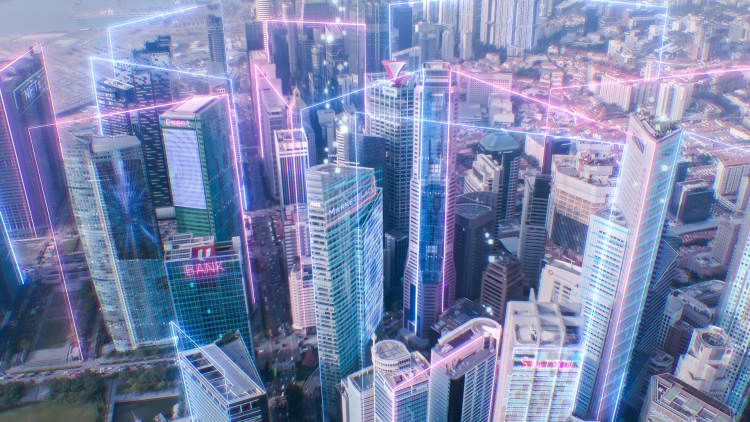ChatGPT sign displayed on OpenAI website displayed on a laptop screen and OpenAI logo displayed on a phone screen are seen in this illustration photo taken in Krakow, Poland on February 2, 2023.
Jakub Porzycki | Nurphoto | Getty Images
What is ChatGPT? I asked the buzzy artificial intelligence chatbot, which has ignited conversation in schools, corporate boardrooms and social media, to explain itself.
In its own description, ChatGPT is “an AI-powered chatbot developed by OpenAI, based on the GPT (Generative Pretrained Transformer) language model. It uses deep learning techniques to generate human-like responses to text inputs in a conversational manner.”
The tool is the talk of the business world. It has been mentioned on earnings calls by management from a range of companies including oil giants, banks — and even the industrial behemoth Caterpillar.
It has also sparked concerns over potential abuses. In classrooms, students have used ChatGPT to generate entire essays, while hackers have begun testing it to write malicious code.
So what is ChatGPT, exactly? Here’s a simple guide on all you need to know about the popular AI chatbot.
ChatGPT is an AI chatbot developed by San Francisco-based startup OpenAI. OpenAI was co-founded in 2015 by Elon Musk and Sam Altman and is backed by well-known investors — most notably Microsoft.
It is one of several examples of generative AI. These are tools that allow users to enter written prompts and receive new human-like text or images and videos generated by the AI.
ChatGPT provides an AI-generated answer to the query “Tell me about ChatGPT.”
Leon Neal | Getty Images
Prior examples include Dall-E, a text-to-image program from OpenAI that garnered attention from people captivated by its ability to come up with realistic, often absurd, pictures that match people’s text descriptions.
Lensa, an app based on open-source AI project Stable Diffusion, has been used to turn selfies into illustrious self-portraits inspired by everything from sci-fi to anime.
In ChatGPT’s case, the service is a text-based tool that can produce human-like responses to user requests — from poetry in the style of William Shakespeare to advice on what to do for a child’s birthday party.
ChatGPT is powered by a large language model, or LLM, meaning it’s programmed to understand human language and generate responses based on large corpora of data.
ChatGPT’s LLM is called GPT-3.5. It is an upgrade of OpenAI’s GPT-3 language model.
With a whopping 175 billion parameters, GPT-3 is one of the largest and most powerful language processing AI models to date.
What makes ChatGPT so impressive is its ability to produce human-like responses, thanks in no small part to the vast amounts of data it is trained on.
“What’s exciting is that the responses are more and more human-like, so what you’re seeing is things that we did not think computers could do before,” Jeffrey Wong, global chief innovation officer at professional services firm EY, told CNBC.
Another thing that differentiates ChatGPT is its ability to log context from users’ earlier messages in a thread and use it to form responses later in the conversation.
No generative AI application has quite managed to achieve the kind of influence and virality that ChatGPT has.
It has been the subject of countless memes and the talk of the business community at the World Economic Forum in Davos, Switzerland, last month. Chinese tech giant Baidu made its own version called Ernie Bot.
The chatbot signed up 1 million in the five days after its release, according to a Dec. 5 tweet from Altman. By January, ChatGPT had amassed 100 million active users only two months into its launch, making it the fastest-growing consumer application in history, according to a UBS note published last week.
It took TikTok nine months to reach 100 million users and Instagram two and a half years.
Jan. 31 was the biggest-ever day for ChatGPT, with its website garnering a record 28 million daily visits, according to data from Similarweb. That was up 165% from a month ago.
One reason for ChatGPT’s popularity is its accessibility. The service is public to anyone via the OpenAI website, and its potential applications range from school homework to legal briefs.
The timing has also played a part, according to Wong.
“When we come out of pandemics, you typically see this burst of creativity,” he said. “The biggest example is, after the Black Plague, there was this Renaissance, this burst of creativity across the board.”
Microsoft is betting billions on ChatGPT’s owner, OpenAI. In late January, the tech titan announced a multiyear, multibillion-dollar investment deal with OpenAI.
Microsoft declined to disclose a specific dollar amount. A report from Semafor said the Redmond, Washington tech giant was in talks to invest as much as $10 billion in the company. Microsoft previously invested $1 billion into OpenAI.
On Tuesday, Microsoft held a press event where it announced new AI-powered updates to its Bing search engine and Edge browser. Altman confirmed Microsoft had incorporated some of OpenAI’s GPT-3.5 language technologies into Bing.

That was a day after Google unveiled its own response to ChatGPT, called Bard AI. The company plans to start rolling Bard out in Google Search in the coming weeks.
ChatGPT is seen as a threat to Google. Rather than turn to the web search pioneer for your most burning questions, people could rely on ChatGPT.
Google was actually early to the advanced conversational AI game, through the launch of its own large language model called Lamda in 2021. It missed the boat on launching its own consumer product based on Lamda — and hopes to change that with Bard, which is powered by the language model.
ChatGPT has its limitations. Responses from the chatbot can contain factual inaccuracies. For example, it can invent fictitious historical names and books that don’t exist, or fail to solve certain math problems.
ChatGPT’s knowledge is still limited to 2021 data, but may improve with time. Going forward, the expectation is that ChatGPT will be the precursor to much more advanced AI systems.
For now, experts say generative AI isn’t yet capable of achieving human-like, “general” intelligence.
Artificial general intelligence, or AGI, is often considered the holy grail of the AI community. It most commonly refers to the ability of an intelligent agent to understand or learn any intellectual task that a human being can.
Plenty of companies hope to achieve that, from OpenAI to Google’s DeepMind.
The possibilities of GPT-3 have already led to excitement about OpenAI’s next-generation LLM model, GPT-4.
Tempering expectations, OpenAI’s Altman pushed back on the hype surrounding GPT-4, stating in a recent interview with StrictlyVC that people were “begging to be disappointed.”
WATCH: What is Web3? We ask the man who invented the word










